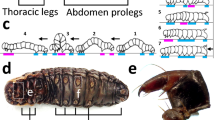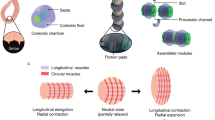Abstract
In the learning of locomotion behavior of a stinkbug Erthesina fullo, the seeked principle of its locomotion can be an important inspiration on the design of six-legged robot. To achieve this goal, in this paper, locomotion behavior of stinkbugs on glass and plastic foam are recorded. Hereby, variation in spatial and temporal kinematics of level, vertical and inverted locomotion is analyzed. Differential leg function and adhesive mechanism as well as the advantage of non-isometric legs of insects are presented. With increasing stride frequency, the speed of level, vertical and inverted locomotion can be higher without adjusting stride length. Variation in gait characteristics between level and vertical locomotion is very little, but lower speed and larger duty factor of inverted locomotion can be occurred while climbing on glass. On the surface of vertical and inverted plastic foam, stinkbugs cannot walk steady and agilely due to its adhesive mechanism.







Similar content being viewed by others
References
Chen CQ, Cui JZ, Duan HL et al (2011) Perspectives in mechanics of heterogeneous solids. Acta Mech Sol Sin 24:1–26
Dickinson MH, Farley CT, Full RJ et al (2000) How animals move: an integrative view. Science 288:100–106
Lu YX (2004) Significance and progress of bionics. J Bionic Eng 1:1–3
Bi SH, Zong GH (2001) Some ideas about bionic machines and bionic manufacture of our country in the early twenty first century. China Mech Eng 12:1201–1204
Wang ZY, Wang JT, Ji AH et al (2010) Gecko’s movement behavior and dynamics research on ceiling surface. Chin Sci Bull 55:841–848
Frantsevich L, Ji AH, Dai ZD et al (2008) Adhesive properties of the arolium of a lantern-fly, lycorma delicatula. J Insect Physiol 54:818–827
Gorb SN (2003) Attachment of insects. The 4th Shanghai Roundtable. Nature as engineer and teacher: learning for technology from biological systems. Shanghai, p 8211
Manter JT (1938) The dynamics of quadrupedal walking. J Exp Biol 15:522–540
Damme RV, Aerts P, Vanhooydonck B (1997) No trade-off between sprinting and climbing in two populations of the lizard podarcis hispanica. Biol J Linn Soc 60:493–503
Irschick DJ, Vanhooydonck B, Herrel A et al (2003) Effects of loading and size on maximum power output and gait characteristics in geckos. J Exp Biol 206:3923–3934
Autumn K, Hsieh ST, Dudek DM et al (2006) Dynamics of geckos running vertically. J Exp Biol 209:260–272
Chen JJ, Peattie AM, Autumn K et al (2006) Differential leg function in a sprawled-posture quadrupedal trotter. J Exp Biol 209:249–259
Li HK, Dai ZD, Shi AJ et al (2009) Angular observation of joints of geckos moving on horizontal and vertical surfaces. Chin Sci Bull 54:592–598
Zaaf A, Damme RV, Herrel A et al (2001) Spatio-temporal gait characteristics of level and vertical locomotion in a ground-dwelling and a climbing gecko. J Exp Biol 204:1233–1246
Zaaf A, Herrel A, Aerts P et al (1999) Morphology and morphometrics of the appendicular musculature in geckoes with different locomotor habits (lepidosauria). Zoomorphology 119:9–22
Ting LH, Blickhan R, Full RJ (1994) Dynamic and static stability in hexapedal runners. J Exp Biol 197:251–269
Justin ES, Philip JH, Full RJ (2004) Dynamic and stability of insect locomotion: a hexapedal model for horizontal plane motions. Biol Cybern 91:76–90
Wang ZY, Wang JT, Ji AH et al (2009) The measurement of reaction force in spider (ornithoctonus huwena). Chin J Prog Nat Sci 19:883–888
Jiao YK, Gorb S, Scherge M (2000) Adhesion measured on the attachment pads of tettigonia viridissima (Orthoptera, Insecta). J Exp Biol 203:1887–1895
Spolenak R, Gorb S, Gao HJ et al (2005) Effects of contact shape on the scaling of biological attachments. Proc R Soc A 461:305–309
Dai ZD, Gorb SN, Schwarz U (2002) Roughness-dependent friction force of the tarsal claw system in the beetle Pachnoda marginata (Coleoptera, Scarabaeidae). J Exp Biol 205:2479–2488
Gorb SN (2002) Attachment devices of insect cuticle. Kluwer Academic Publishers, Berlin
Ji AH, Han LB, Dai ZD (2011) Adhesive contact in animal: morphology, mechanism and bio-inspired application. J Bio Eng 8:345–356
Ji AH, Yan HB, Shen H et al (2007) Three-dimensional contact force measuring during Erthesina fullo locomoting on positive/zero surface. Chin J Nanjing Univ Aeron Astron 39:80–83
Full RJ, Blickhan R, Ting LH (1991) Leg design in hexapedal runners. J Exp Biol 158:369–390
Beutel RG, Gorb SN (2001) Ultrastructure of attachment specializations of hexapods (Arthropoda): evolutionary patterns inferred from a revised ordinal phylogeny. J Zoo Syst Evol Res 39:177–207
Wang ZY, Wang JT, Ji AH et al (2011) Movement behavior of a spider on a horizontal surface. Chin Sci Bull 56:2748–2757
Acknowledgments
This work was supported by the NUAA Fundamental Research Funds (NS2013094).
Author information
Authors and Affiliations
Corresponding author
About this article
Cite this article
Ji, A., Lei, Y., Wang, J. et al. Variation in spatial and temporal kinematics of level, vertical and inverted locomotion on a stinkbug Erthesina fullo . Chin. Sci. Bull. 59, 3333–3340 (2014). https://doi.org/10.1007/s11434-014-0310-x
Received:
Accepted:
Published:
Issue Date:
DOI: https://doi.org/10.1007/s11434-014-0310-x




